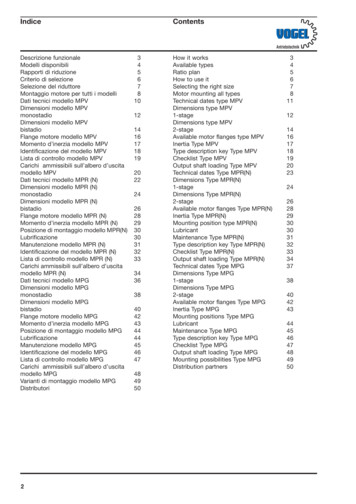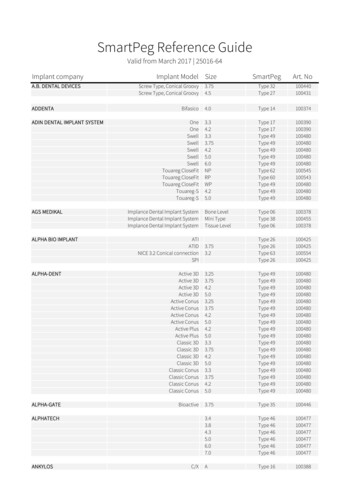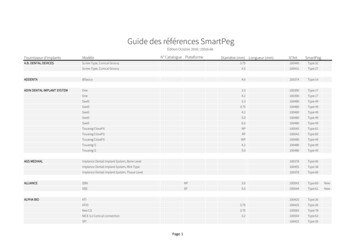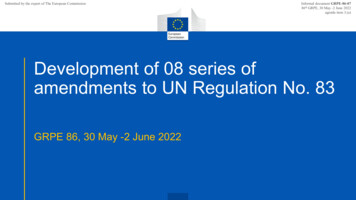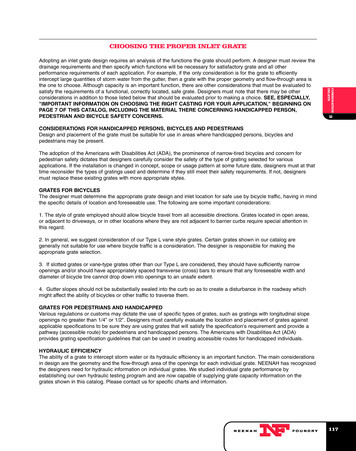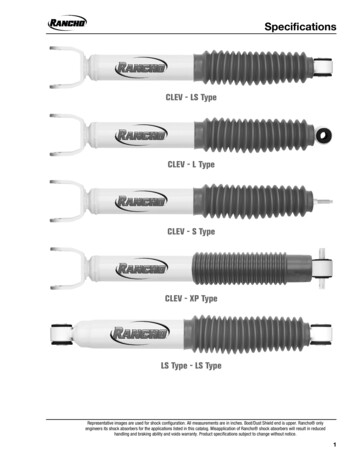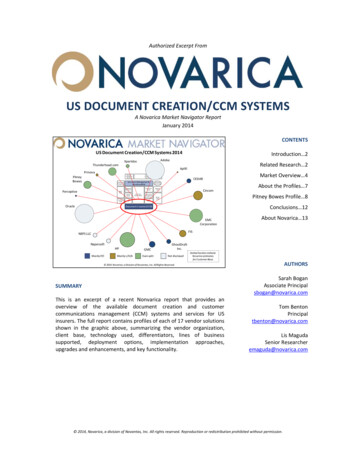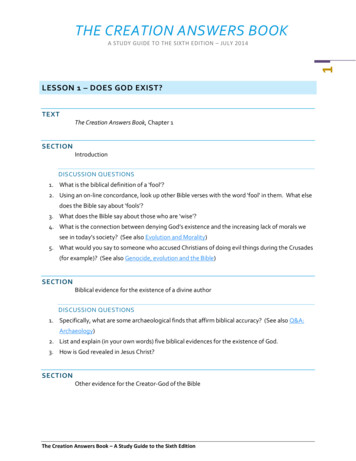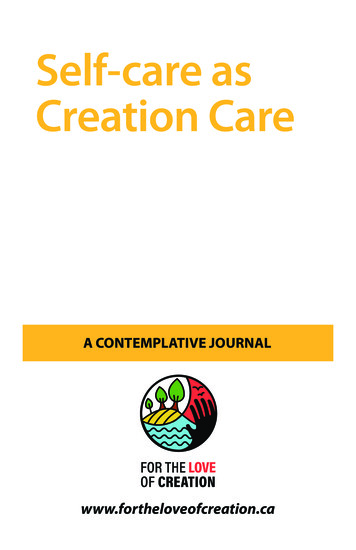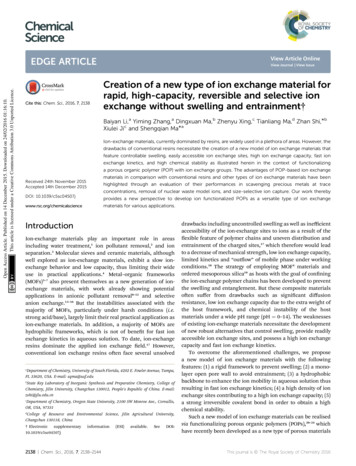
Transcription
ChemicalScienceView Article OnlineOpen Access Article. Published on 14 December 2015. Downloaded on 24/02/2016 01:16:10.This article is licensed under a Creative Commons Attribution 3.0 Unported Licence.EDGE ARTICLECite this: Chem. Sci., 2016, 7, 2138View Journal View IssueCreation of a new type of ion exchange material forrapid, high-capacity, reversible and selective ionexchange without swelling and entrainment†Baiyan Li,a Yiming Zhang,a Dingxuan Ma,b Zhenyu Xing,c Tianliang Ma,d Zhan Shi,*bXiulei Jic and Shengqian Ma*aIon-exchange materials, currently dominated by resins, are widely used in a plethora of areas. However, thedrawbacks of conventional resins necessitate the creation of a new model of ion exchange materials thatfeature controllable swelling, easily accessible ion exchange sites, high ion exchange capacity, fast ionexchange kinetics, and high chemical stability as illustrated herein in the context of functionalizinga porous organic polymer (POP) with ion exchange groups. The advantages of POP-based ion exchangematerials in comparison with conventional resins and other types of ion exchange materials have beenReceived 24th November 2015Accepted 14th December 2015highlighted through an evaluation of their performances in scavenging precious metals at traceconcentrations, removal of nuclear waste model ions, and size-selective ion capture. Our work therebyDOI: 10.1039/c5sc04507jprovides a new perspective to develop ion functionalized POPs as a versatile type of ion exchangewww.rsc.org/chemicalsciencematerials for various applications.IntroductionIon-exchange materials play an important role in areasincluding water treatment,1 ion pollutant removal,2 and ionseparation.3 Molecular sieves and ceramic materials, althoughwell explored as ion-exchange materials, exhibit a slow ionexchange behavior and low capacity, thus limiting their wideuse in practical applications.4 Metal–organic frameworks(MOFs)5–7 also present themselves as a new generation of ionexchange materials, with work already showing potentialapplications in anionic pollutant removal8–12 and selectiveanion exchange.13–16 But the instabilities associated with themajority of MOFs, particularly under harsh conditions (i.e.strong acid/base), largely limit their real practical application asion-exchange materials. In addition, a majority of MOFs arehydrophilic frameworks, which is not of bene t for fast ionexchange kinetics in aqueous solution. To date, ion-exchangeresins dominate the applied ion exchange eld.17 However,conventional ion exchange resins o en face several unsolvedaDepartment of Chemistry, University of South Florida, 4202 E. Fowler Avenue, Tampa,FL 33620, USA. E-mail: sqma@usf.edubState Key Laboratory of Inorganic Synthesis and Preparative Chemistry, College ofChemistry, Jilin University, Changchun 130012, People's Republic of China. E-mail:zshi@jlu.edu.cncDepartment of Chemistry, Oregon State University, 2100 SW Monroe Ave., Corvallis,OR, USA, 97331dCollege of Resource and Environmental Science, Jilin Agricultural University,Changchun 130118, China† Electronic supplementary10.1039/c5sc04507jinformation2138 Chem. Sci., 2016, 7, 2138–2144(ESI)available.SeeDOI:drawbacks including uncontrolled swelling as well as inefficientaccessibility of the ion-exchange sites to ions as a result of the exible feature of polymer chains and uneven distribution andentrainment of the charged sites,17 which therefore would leadto a decrease of mechanical strength, low ion exchange capacity,limited kinetics and “out ow” of mobile phase under workingconditions.18 The strategy of employing MOF4 materials andordered mesoporous silica19 as hosts with the goal of con ningthe ion-exchange polymer chains has been developed to preventthe swelling and entanglement. But these composite materialso en suffer from drawbacks such as signi cant diffusionresistance, low ion exchange capacity due to the extra weight ofthe host framework, and chemical instability of the hostmaterials under a wide pH range (pH ¼ 0–14). The weaknessesof existing ion-exchange materials necessitate the developmentof new robust alternatives that control swelling, provide readilyaccessible ion exchange sites, and possess a high ion exchangecapacity and fast ion exchange kinetics.To overcome the aforementioned challenges, we proposea new model of ion exchange materials with the followingfeatures: (1) a rigid framework to prevent swelling; (2) a monolayer open pore wall to avoid entrainment; (3) a hydrophobicbackbone to enhance the ion mobility in aqueous solution thusresulting in fast ion exchange kinetics; (4) a high density of ionexchange sites contributing to a high ion exchange capacity; (5)a strong irreversible covalent bond in order to obtain a highchemical stability.Such a new model of ion exchange materials can be realisedvia functionalizing porous organic polymers (POPs),20–24 whichhave recently been developed as a new type of porous materialsThis journal is The Royal Society of Chemistry 2016
View Article OnlineOpen Access Article. Published on 14 December 2015. Downloaded on 24/02/2016 01:16:10.This article is licensed under a Creative Commons Attribution 3.0 Unported Licence.Edge Articlebecause of their amenability of design and modular nature, highsurface areas, adjustable pore sizes, functionalizable surfaces,and exceptional chemical stability as well as their potential forapplications in areas including gas storage/separation,25–38 catalysis,39–45 pollutant removal,46–48 and energy storage.49–54 We speculate that if ion-exchange groups can be gra ed to thehydrophobic backbones of the highly porous robust POPframework, a high density of readily accessible ion-exchange sitesthat are arranged into a three-dimensional nanospace will beachieved (Scheme 1). This is anticipated to afford new ionexchange materials with a high ion-exchange capacity, fast ionexchange kinetics, together with controlled swelling, easilyaccessible ion exchange sites as well as a high chemical stability.In addition, the well tailorable framework and controllable poresize of POPs provide an opportunity to tune the framework toselectively adsorb ion guest molecules via size-exclusion,15a property conventional ion-exchange resins fail to provide.In this contribution, we demonstrate, for the rst time, a newtype of ion exchange material capable of rapidly exchangingions with a high capacity, great reversibility and extra highchemical stability without swelling or entrainment. The afforded POP-based ion exchange materials can be used as a versatileplatform in the ion exchange-based separation process. To thebest of our knowledge, the material presented is the only kind ofion exchange material possessing all of the features given above(Table 1). Our studies therefore not only lay a foundation fordeveloping POPs as a new type of ion exchange material circumventing the issues of swelling and entanglement encountered in conventional ion exchange resins, but also advancePOP-based ion exchange materials as a new platform forapplications in ion selective separation and puri cation.Results and discussionSynthesis and characterizationWe chose PAF-1 (ref. 55) (PAF ¼ porous aromatic framework)[also known as (a.k.a.) PPN-6]56,57 as the model material for the“proof of concept” because of its very high surface area andexceptional water/chemical stabilities. In principle, a desiredion-exchange group can be gra ed onto any POPs for eithercation exchange or anion exchange. Herein, we focus on functionalizing the POP for anion exchange as exempli ed bygra ing the strong basic trimethylammonium hydroxide moietyonto PAF-1. Chloromethylation of PAF-1 followed by the treatment with trimethylamine in ethanol yielded PAF-1-CH2N (CH3)3Cl . PAF-1-CH2N (CH3)3OH was obtained via ionexchange of PAF-1-CH2N (CH3)3Cl in 1 M NaOH (Scheme 2,Fig. S1 and S2, ESI†).Scheme 1Illustration of functionalizing POP for reversible anionexchange.This journal is The Royal Society of Chemistry 2016Chemical ScienceThe successful gra ing of the trimethylammoniumhydroxide moiety onto PAF-1 was con rmed using Fouriertransform infrared spectroscopy (FT-IR), solid-state 13C NMRand elemental analysis studies. When compared with pristinePAF-1, the FT-IR spectra of dehydrated PAF-1-CH2N (CH3)3OH shows the aliphatic C–H stretching band at 2953 cm 1 and thecharacteristic band for C–N at 1280 cm 1 (Fig. S3, ESI†). Solidstate 13C NMR studies show the chemical shi s of CH3 and CH2at 51.9 ppm and 63.0 ppm, suggesting the successful gra ing of–CH2N (CH3)3OH groups to the phenyl rings in PAF-1 (Fig. S4,ESI†). Elemental analysis reveals a nitrogen content of 3.88 wt%corresponding to 2.8 mmol g 1 of CH2N (CH3)3OH groups inPAF-1-CH2N (CH3)3OH , suggesting 44% of the phenyl ringsare gra ed with one CH2N (CH3)3OH group. N2 sorptionisotherms collected at 77 K (Fig. 1) show a signi cant decreasein the Brunauer–Emmett–Teller (BET) surface area from 4715 to505 m2 g 1 and a reduction of pore volume from 2.0 to 0.27 cm3g 1 a er modi cation of PAF-1 with –CH2N (CH3)3OH .Meanwhile, the pore size is also reduced from 1.5 nm for PAF1 to 1.1 nm for PAF-1-CH2N (CH3)3OH (Fig. S5, ESI†). Theseresults are consistent with the modi cation of the functionalgroups onto the POPs.Ion exchange kinetic performances of POP-based ionexchange materialsThe extraction of AuX4 (X ¼ Cl or Br) or Au(CN)2 are twodifferent routes for scavenging precious metal from preciousmetal electroplating waste water, which features economic andenvironmental incentives.4,58 To evaluate the merit of the POPbased ion exchange materials, we used the extraction of theAuCl4 ion from aqueous solutions as a model experiment. Weobserved PAF-1-CH2N (CH3)3Cl extracting 96% of the AuCl4 ion within 2 min (Fig. 2a). The commercial ion exchange resin,Amberlyst-A26 possessing the same ion-exchange groupN (CH3)3Cl and the composited ion exchange materialPVBTAH–ZIF-84 took at least 30 min to extract the same amountof the AuCl4 ion under the same conditions (Fig. 2b, S6, ESI†).We also tested the ion capture performances of LDHs,59 ITC-4,15ZIF-8,60 and PAF-1 using the same AuCl4 model experiment(Fig. 2b, S6, ESI†). These materials exhibit a low ion captureability and slow kinetic behaviors extracting 25–50% of theAuCl4 ion a er 120 min. We also compared the ion exchangeperformances of stable ion exchange materials under suchconditions including PAF-1-CH2N (CH3)3Cl , Amberlyst-A26and LDHs based on the same amount of active exchange sites,and PAF-1-CH2N (CH3)3Cl also shows signi cant advantagesover Amberlyst-A26 and LDHs (Fig. S7, ESI†). Furthermore, weexamined the performances of PAF-1-CH2N (CH3)3OH as anion-exchange material in extracting ppm levels of gold cyanidein water solution. As shown in Fig. 2c, PAF-1-CH2N (CH3)3OH can rapidly capture Au(CN)2 ions; and 99% of the Au(CN)2 anion can be extracted within 10 seconds, which is in strikingcontrast with only 15% extraction of the Au(CN)2 anion by theAmberlyst-A26 commercial resin. Equilibrium adsorption isalso established at 10 seconds for PAF-1-CH2N (CH3)3OH ,compared to 15 min for Amberlyst-A26. A similar trend was alsoChem. Sci., 2016, 7, 2138–2144 2139
View Article OnlineChemical ScienceOpen Access Article. Published on 14 December 2015. Downloaded on 24/02/2016 01:16:10.This article is licensed under a Creative Commons Attribution 3.0 Unported Licence.Table 1Edge ArticleComparison of the features of POP-based ion exchange materials with other types of ion exchange materialsIon materialsStabilityaIon exchangerateIon exchangecapacitySwellingIon sites entanglementPOP-based ion exchange materialIon-exchange resinsResin composite with MOF ormesoporous silicaMolecular sievesCeramic In both strong acid and strong base.Synthetic route of PAF-1-CH2N (CH3)3OH . (a) CH3COOH/HCl/H3PO4/HCHO, 363 K, 3 days; (b) trimethylamine, ethanol,353 K, 3 days; (c) 1 M NaOH, twice.Scheme 2hydrophobicity as well as the strong coulombic interactionsbetween the charged framework and extracts. To gain furtherinsight into the mobility behavior of ions in the porous framework, we measured the conductivity of Au(CN)2 @PAF-1-CH2N (CH3)3OH and Au(CN)2 @Amberlyst-A26 (Fig. S12, ESI†).Analysis of Au(CN)2 @PAF-1-CH2N (CH3)3OH in an ambientenvironment gave a conductivity of 3.23 10 7 S cm 1 whilethe same measurement on Au(CN)2 @Amberlyst-A26 produceda conductivity of 1.21 10 7 S cm 1, indicating a higherAu(CN)2 ion mobility in PAF-1-CH2N (CH3)3OH .16 Theseresults are consistent with the faster extraction kineticsobserved in PAF-1-CH2N (CH3)3OH .Ion exchange capacity of POP-based ion exchange materialsFig. 1 N2 sorption isotherms of PAF-1 (red) and PAF-1-CH2N (CH3)3OH (green).observed when using PAF-1-CH2N (CH3)3OH and AmberlystA26 with the same amount of ion exchange sites (Fig. S8, ESI†).The appearance of the IR peak at 2144 cm 1 can be attributed tothe uptake of Au(CN)2 by PAF-1-CH2N (CH3)3OH (Fig. S9,ESI†). The adsorption rate constant (k2) was tted with thepseudo-second-order kinetic model (Fig. S10 and S11, ESI†) andthe value was determined to be 50.4 g mg 1 min 1 (141 mmolmg 1 min 1) for PAF-1-CH2N (CH3)3OH , which is two orderof-magnitude higher than the Amberlyst-A26 resin with a k2value of 0.25 g mg 1 min 1 (0.78 mmol mg 1 min 1) under thesame conditions. The fast ion exchange of the POP-basedion exchange materials can be attributed to the highly accessible ion-exchange sites in the open pores and the fast ionmobility in aqueous solution bene ting from the framework2140 Chem. Sci., 2016, 7, 2138–2144The dry weight ion-exchange capacity of PAF-1-CH2N (CH3)3Cl measured by AgNO3 titration is 3.4 meq g 1, comparable to thatof Amberlyst-A26 (Table S1, ESI†). However, the wet volume ionexchange capacity (2.4 meq mL 1) of PAF-1-CH2N (CH3)3OH isthree times that of Amberlyst-A26 (0.8 meq mL 1) (Table S1,ESI†), which experiences dramatic swelling as a result of thenature of its exible polymer chains. We also assessed themaximum working capacities of PAF-1-CH2N (CH3)3OH andAmberlyst-A26 using Au(CN)2 extraction. The equilibriumadsorption isotherm data, tted using the Langmuir model,yielded a high correlation coefficient ( 0.9998) (Fig. S13 andS14, ESI†). Under the same working conditions, the maximumdry weight working capacity of PAF-1-CH2N (CH3)3OH iscomparable to that of Amberlyst-A26 (Fig. S15, ESI†). Nonetheless, the wet volume working capacity of PAF-1-CH2N (CH3)3OH is 2.9 times higher than that of Amberlyst-A26 (Fig. 3). Weascribe the signi cant difference to the high density of highlyaccessible ion-exchange sites distributed on the rigid 3Dframework. Furthermore, another reason for the high wetvolume working capacity of PAF-1-CH2N (CH3)3OH shouldstem from the inherent robust framework of PAF-1,55,56 whichdoes not exhibit the possible swelling as observed for exiblepolymers.4,18 In addition, both the dry weight ion-exchangecapacity and wet volume ion-exchange capacity of PAF-1-CH2N (CH3)3OH are also higher than the composited ion exchangematerial PVBTAH–ZIF-8 (Fig. 3, S15 and S16, ESI†). This shouldpresumably be due to the addition of the extra MOF framework,decreasing effective ion exchange sites in the compositedmaterials. In addition, the volumetric uptake amount ofThis journal is The Royal Society of Chemistry 2016
View Article OnlineOpen Access Article. Published on 14 December 2015. Downloaded on 24/02/2016 01:16:10.This article is licensed under a Creative Commons Attribution 3.0 Unported Licence.Edge ArticleChemical ScienceKinetics investigation of PAF-1-CH2N (CH3)3Cl . (a) UV-vis spectra of AuCl4 aqueous solution in the presence of PAF-1-CH2N (CH3)3Cl monitored with time. (b) Comparison of the ion exchange performances of PAF-1-CH2N (CH3)3Cl and other ion exchangematerials in extracting AuCl4 . (c) Au(CN)2 exchange kinetics of PAF-1-CH2N (CH3)3OH (red) and Amberlyst-A26 (green) with an Au(I) initialconcentration of 15 ppm in KAu(CN)2 solution.Fig. 2 for studying pertechnetate uptake since both are group 7 oxoanions.9 As shown in Fig. 4, almost 99% of the MnO4 can beremoved by PAF-1-CH2N (CH3)3OH in less than 5 min,whereas it takes at least 30 min to reach the same removalcapacity for commercial Amberlyst-A26 under the same conditions. Furthermore, we also compared the ion exchangeperformance of PAF-1-CH2N (CH3)3OH with other anionexchange materials including LDHs, PVBTAH–ZIF-8 and SLUG21 (ref. 9) (Fig. 4, S18, ESI†). They show an even worse capabilityin removing the MnO4 ions, and even a er 60 min only 31%,92% and 98% of the MnO4 ions can be removed for LDHs,Fig. 3 Volumetric Au(I) adsorption isotherms for PAF-1-CH2N (CH3)3OH , Amberlyst-A26 and PVBTAH–ZIF-8.Au(CN)2 in PAF-1-CH2N (CH3)3OH is also higher than inAmberlyst-A26 with the same mol of active exchange sites(Fig. S17, ESI†). These results further highlight the advantagesof the functionalized POPs as a new platform for ion exchange.Investigation of POP-based ion exchange materials in nuclearwaste model ion removalIn addition, we also investigated the potential applicationof POP-based ion exchange materials for the removal of radioactive technetium (Tc-99), which is a highly problematic ion innuclear waste. Permanganate has been used as the model ionThis journal is The Royal Society of Chemistry 2016Fig. 4 Comparison of the ion exchange performances of PAF-1CH2N (CH3)3OH and other ion exchange materials in removingmodel MnO4 ions.Chem. Sci., 2016, 7, 2138–2144 2141
View Article OnlineChemical ScienceOpen Access Article. Published on 14 December 2015. Downloaded on 24/02/2016 01:16:10.This article is licensed under a Creative Commons Attribution 3.0 Unported Licence.PVBTAH–ZIF-8 and SLUG-21, respectively (Fig. 4). For the stableion exchange materials of PAF-1-CH2N (CH3)3OH , AmberlystA26 and LDHs with the same mol of active exchange sites, PAF1-CH2N (CH3)3OH is also superior to Amberlyst-A26 and LDHs(Fig. S19, ESI†). These results suggest that POP based ionexchange materials will have obvious advantages for theremoval of pertechnetate ions when compared with other typesof ion exchange materials.Size selective ion exchange in POP-based ion exchangematerialsBeyond the fast ion exchange rate, high ion exchange capacity,and controllable swelling, POP-based ion exchange materials canbe employed to selectively capture ion compounds via a sizeexclusion effect. To illustrate the size-selective ion capture, twoanionic dyes, Methyl Blue (MB) and Orange G (OG) which havethe same charges but different dimensions (13.89 14.35 24.49 Å for MB vs. 5.44 10.14 15.64 Å for OG) were used forinvestigations. Given that the molecular dimensions of OG alonga certain orientation are smaller than the pore size of PAF-1CH2N (CH3)3OH (11–12.7 Å), PAF-1-CH2N (CH3)3OH canquickly and completely capture the OG molecules in 10 minutes,whereas the MB molecules remain in the solution (Fig. 5). Incontrast, conventional resins and LDHs, with accessible chargeson the particle surfaces, fail to effectively separate dye moleculesvia a size exclusion effect (Fig. S20a and b, ESI†). In addition, theMOF ITC-4 was also used to separate two dyes in aqueous solution as a control. The larger MB molecules instead of the smallerOG molecules were quickly extracted in ICT-4 (Fig. S20c, ESI†).This could presumably be due to the framework collapse of ICT-4in an aqueous environment, which remains an issue in practicalapplication for the majority of MOFs.56Stability study and reversible ion exchange in POP-based ionexchange materialsConsidering that harsh conditions such as strong acid andstrong base environments are o en involved in the applicationEdge Articleof ion exchange materials, high chemical stability is an essential criterion for an ion exchange material. The high chemicalstability of PAF-1-CH2N (CH3)3OH was veri ed by immersingthe PAF-1-CH2N (CH3)3OH sample successively with 1.0 M HCland 1.0 M NaOH. The sample experienced virtually no surfacearea drop based on the N2 sorption isotherms collected at 77 K(Fig. S21, ESI†). This is advantageous compared to mesoporoussilica and MOF materials, which experience framework collapsea er the same treatments because of their chemical instabilityunder such harsh conditions (Fig. S22 and S23, ESI†).The fast and reversible ion-exchange of PAF-1-CH2N (CH3)3OH was examined by soaking the Au(CN)2 anionloaded PAF-1-CH2N (CH3)3OH (Au(CN)2 content: 1.03 mmolg 1) in 1 M NaOH ethanolic solution (water : ethanol, 1 : 1 v/v).Over 90% of the Au(CN)2 anion was eluted in 40 seconds anda complete elution was obtained within 5 min (Fig. S24, ESI†).PAF-1-CH2N (CH3)3OH can be readily recycled as proven byvirtually no loss of Au(I) uptake capacity a er ve cycles(Fig. S25, ESI†). Nonetheless, for the practical application of ionexchange materials in the recovery of gold, the elution of theseions is mainly on the basis of passing anions contained inaqueous solution through an Au(CN)2 accumulated ionexchange column;61 this aspect of work will be conducted in thenear future.It is envisioned that the ideal ion-exchange materialpossesses a high ion exchange capacity (both gravimetric andvolumetric), rapid ion exchange rate (fast ion exchangekinetics), high chemical stability (under both strong acidic andbasic conditions), and ease of regeneration as well as negligibleswelling and minimum entrainment. This could be targeted viafunctionalizing a highly porous and highly robust porousorganic polymer (POP) with ion exchange groups as exempli edherein in the context of gra ing the strong basic trimethylammonium hydroxide moiety onto the POP of PAF-1 to affordPAF-1-CH2N (CH3)3OH for anion exchange, which outperforms the benchmark resin of Amberlyst-A26 and other types ofion-exchange materials. In principle, outstanding performancesin cation exchange can also be anticipated when a desiredcation exchange site is gra ed into POPs, and work along thisline is currently underway in our laboratory. Although the highcost of PAF-1 would be a concern for the practical utilization offunctionalized PAF-1 for ion exchange, the ion exchange groupscan be readily gra ed into other POPs that are constructed fromvarious organic building blocks derived from a variety ofresources through economical reaction processes,19,46 thuspaving a way to develop functionalized POPs as a new type ofion-exchange material for rapid, high-capacity, reversible andselective ion exchange without swelling and entrainment.ConclusionsFig. 5 UV-vis spectra of OG/MB aqueous solution in the presence ofPAF-1-CH2N (CH3)3OH .2142 Chem. Sci., 2016, 7, 2138–2144In summary, we have proposed a new model of ion exchangematerials that feature highly open pores, monolayer pore walls,and a covalently linked rigid hydrophobic framework viagra ing ion exchange sites onto porous organic polymers(POPs). The resultant POP-based ion exchange materials exhibita high ion exchange capacity, fast ion exchange kinetics, andThis journal is The Royal Society of Chemistry 2016
View Article OnlineOpen Access Article. Published on 14 December 2015. Downloaded on 24/02/2016 01:16:10.This article is licensed under a Creative Commons Attribution 3.0 Unported Licence.Edge Articlehigh chemical stability, and meanwhile can overcome thedrawbacks of other ion-exchange materials, particularlyswelling and entanglement for conventional ion exchangeresins, as exempli ed in the studies on scavenging preciousmetals at trace concentrations and removal of nuclear wastemodel ions. In addition, POP-based ion exchange materials canbe designed for the selective capture of ions, a propertyconventional ion exchange resin cannot provide. Our resultshighlight the advantages of POP-based ion exchange materialscompared to other types of ion exchange materials, and therebyadvance POP-based ion exchange materials as a new platformfor applications in ion selective separation and puri cation.ExperimentalMaterial synthesisA re-sealable ask was charged with PAF-1 (200.0 mg), paraformaldehyde (1.0 g), glacial AcOH (6.0 mL), H3PO4 (3.0 mL),and conc. HCl (20.0 mL). The ask was sealed and heated to90 C for 3 days. The resulting solid was collected, washed withwater and methanol, and then dried under vacuum to producea yellow solid of PAF-1-CH2Cl.57 Subsequently the obtained PAF1-CH2Cl was mixed with 33% trimethylamine ethanol (3.0 g) in100 mL of EtOH under N2 and stirred at 75 C for 3 days. Theresulting solid was collected, washed with water and methanol,and then dried under vacuum to produce PAF-1-CH2N (CH3)3Cl as a yellow powder. Then the PAF-1-CH2N (CH3)3Cl wasexchanged using 100 mL of NaOH (1 M) twice to afford PAF-1CH2N (CH3)3OH . Elemental analysis: experimental result: C:60.44%; H: 7.28%; N: 3.88%; calculated result (based on onefunctional group per two phenyl cycles): C: 80.16%; H: 7.69%; N:5.67%.Ion-exchange experiments for AuCl4 A 40 mL aqueous solution of KAuCl4 (0.835 mM) was added toa 40 mL vial, which was followed by the addition of 20.0 mgsamples to form a slurry. During the stirring period, the mixturewas ltered at intervals through a 0.45 micron membrane lterfor all samples, then the ltrates were analyzed using UV-vis todetermine the concentration of the AuCl4 ions.Ion conductivity studiesThe maximum Au(CN)2 ion loaded samples were used in theconductivity experiment, which were synthesized based onthe following: PAF-1-CH2N (CH3)3OH and Amberlyst-A26(100.0 mg) were added to each Erlenmeyer ask containing1000 ppm KAu(CN)2 solution (50 mL). The mixtures were stirredat room temperature for 3 h, and then were ltered and washedusing water and methanol, then dried under vacuum to obtainAu(CN)2 @PAF-1-CH2N (CH3)3OH and Au(CN)2 @AmberlystA26 for further tests. Pellets of compacted powder sample(13 mm in diameter, thickness around 1 mm) were made usingthe IR pellet at 50 Mpa for 3 minutes. Then the pellets weresandwiched between two gold foils and put into the Swagelokfor an AC impedance spectroscopy measurement. The EISmeasurement is performed using the Biologic VMP3 withThis journal is The Royal Society of Chemistry 2016Chemical Sciencea frequency range between 1 MHz and 1 Hz and a 50 mV (peakvoltage) was applied as AC signals.AcknowledgementsThe authors acknowledge the University of South Florida for nancial support of this work.Notes and references1 S. Wang, E. V. Alekseev, J. Diwu, W. H. Casey, B. L. Phillips,W. Depmeier and T. E. Albrecht-Schmitt, Angew. Chem., Int.Ed., 2010, 49, 1057.2 S. R. J. Oliver, Chem. Soc. Rev., 2009, 38, 1868.3 R. Al-Merey, Z. Hariri and J. Abu Hilal, Microchem. J., 2003,75, 169.4 L. Gao, C.-Y. V. Li, K.-Y. Chan and Z.-N. Chen, J. Am. Chem.Soc., 2014, 136, 7209.5 H.-C. Zhou, J. R. Long and O. M. Yaghi, Chem. Rev., 2012,112, 673.6 S. M. Cohen, Chem. Rev., 2012, 112, 970.7 H.-R. Fu, Z.-X. Xu and J. Zhang, Chem. Mater., 2015, 27, 205.8 H. Fei, D. L. Rogow and S. R. J. Oliver, J. Am. Chem. Soc., 2010,132, 7202.9 H. Fei, M. R. Bresler and S. R. J. Oliver, J. Am. Chem. Soc.,2011, 133, 11110.10 H. Fei and S. R. J. Oliver, Angew. Chem., Int. Ed., 2011, 50,9066.11 H. Fei, C. H. Pham and S. R. J. Oliver, J. Am. Chem. Soc., 2012,134, 10729.12 X. Li, H. Xu, F. Kong and R. Wang, Angew. Chem., Int. Ed.,2013, 52, 13769.13 J. An, C. M. Shade, D. A. Chengelis-Czegan, S. Petoud andN. L. Rosi, J. Am. Chem. Soc., 2011, 133, 1220.14 D. T. Genna, A. G. Wong-Foy, A. J. Matzger and M. S. Sanford,J. Am. Chem. Soc., 2013, 135, 10586.15 X. Zhao, X. Bu, T. Wu, S.-T. Zheng, L. Wang and P. Feng, Nat.Commun., 2013, 4, 2344.16 C. Mao, R. A. Kudla, F. Zuo, X. Zhao, L. J. Mueller, X. Bu andP. Feng, J. Am. Chem. Soc., 2014, 136, 7579.17 C. E. Harland, Ion-exchange: Theory and Practicle, RoyalSociety of Chemistry, London, 2nd edn, 1994.18 A. A. Zagorodni, Ion Exchange Materials Properties andApplications, Elsevier, Oxford, 1st edn, 2007.19 M. Choi, F. Kleitz, D. Liu, H. Y. Lee, W. S. Ahn and R. Ryoo,J. Am. Chem. Soc., 2005, 127, 1924.20 A. I. Cooper, Adv. Mater., 2009, 21, 1291.21 A. Thomas, Angew. Chem., Int. Ed., 2010, 49, 8328.22 X. Zou, H. Ren and G. Zhu, Chem. Commun., 2013, 49, 3925.23 Y. Xu, S. Jin, H. Xu, A. Nagai and D. Jiang, Chem. Soc. Rev.,2013, 42, 8012.24 S. Kandambeth, D. B. Shinde, M. K. Panda, B. Lukose,T. Heine and R. Banerjee, Angew. Chem., Int. Ed., 2013, 52,13052.25 P. Kuhn, A. Forget, D. Su, A. Thomas and M. Antonietti,J. Am. Chem. Soc., 2008, 130, 13333.26 Y. Zhu and W. Zhang, Chem. Sci., 2014, 5, 4957.Chem. Sci., 2016, 7, 2138–2144 2143
View Article OnlineOpen Access Article. Published on 14 December 2015. Downloaded on 24/02/2016 01:16:10.This article is licensed under a Creative Commons Attribution 3.0 Unported Licence.Chemical Science27 N. Huang, X. Ding, J. Kim, H. Ihee and D. Jiang, Angew.Chem., Int. Ed., 2015, 54, 8704.28 M. G. Schwab, B. Fassbender, H. W. Spiess, A. Thomas,X. Feng and K. Mullen, J. Am. Chem. Soc., 2009, 131, 7216.29 D. Yuan, W. Lu, D. Zhao and H.-C. Zhou, Adv. Mater., 2011,23, 3723.30 X. Zhu, C. Tian, S. M. Mahurin, S.-H. Chai, C. Wang,S. Brown, G. M. Veith, H. Luo, H. Liu and S. Dai, J. Am.Chem. Soc., 2012, 134, 10478.31 R. Dawson, L. A. Stevens, T. C. Drage, C. E. Snape,M. W. Smith, D. J. Adams and A. I. Cooper, J. Am. Chem.Soc., 2012, 134, 10741.32 Y. Zhu, H. Long and W. Zhang, Chem. Mater., 2013, 25, 1630.33 H. A. Patel, J. S. Hyun, J. Park, D. P. Chen, Y. Jung, C. T. Yavuzand A. Coskun, Nat. Commun., 2013, 4, 1357.34 P. Arab, M. G. Rabbani, A. K. Sekizkardes, T. İslamoğlu andH. M. El-Kaderi, Chem. Mater., 2014, 26, 1385.35 R. K. Totten, L. L. Olenick, Y. Kim, M. H. Weston,O. K. Farha, J. T. Hupp and S. T. Nguyen, Chem. Sci., 2014,5, 782.36 J. F. van Humbeck, T. M. McDonald, X. Jing, B. M. Wiers,G. Zhu and J. R. Long, J. Am. Chem. Soc., 2014, 136, 2432.37 B. Li, Y. Zhang, R. Krishna, K. Yao, Y. Han, Z. Wu, D. Ma,Z. Shi, T
and elemental analysis studies. When compared with pristine PAF-1, the FT-IR spectra of dehydrated PAF-1-CH 2N (CH 3) 3OH shows the aliphatic C-H stretching band at 2953 cm 1 and the characteristic band for C-N at 1280 cm 1 (Fig. S3, ESI†). Solid-state 13C NMR studies show the chemical shi sofCH 3 and CH 2
